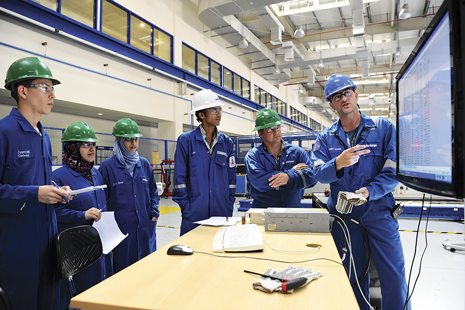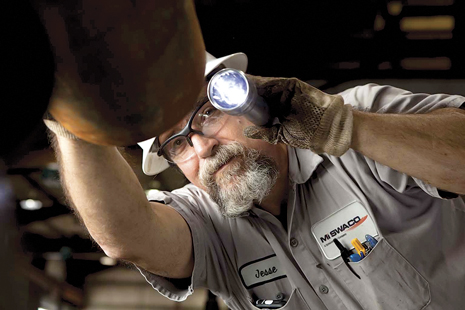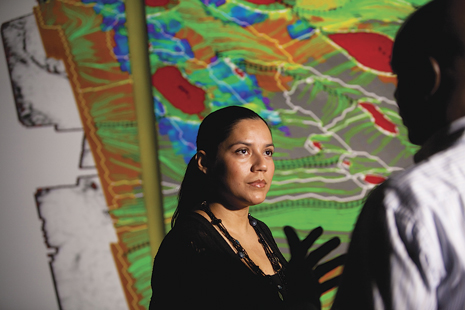RECRUITMENT & RETENTION
The ‘crew change’ challenge facing us all
Today’s competition to recruit and retain both skilled and specially trained employees has become a top priority for oil and gas companies, and will continue to do so as demand increases.
WAYNE FINGER, Recruiting Manager–North America, Schlumberger Ltd.
“Attracting, and keeping, quality recruits is a challenge facing the entire oil and gas industry, and it’s not going to fix itself.”
For years, we have been hearing that message. Almost every speaker, journalist or interviewee refers to the “big crew change,” when asked about the major challenges faced by our industry. The danger is that we have heard this litany so many times, and many industry executives have become inured to it, shrugging it off like a bad memory that we do not want to recall. Well, it is time.
Everyone is aware of the role that technology has played, providing us access to energy resources that are more difficult to find and even more difficult to produce cost-effectively. Despite the challenges, the industry has employed increasingly elegant technological solutions to address ever-more, elusive hydrocarbon resources. But massive oil and gas deposits are not the only dwindling resource. Qualified people are needed, too, and the traditional resource base of these special people has decreased as well, just as the demand for more diverse skill sets has escalated.
In a nutshell, industry employers are in stiff competition for highly skilled and specially trained employees. Every facet of our industry feels the pinch. The expansion of technology-driven solutions has expanded the demand for technologists. This is not a just play on words; only a few decades ago, there was no need for electronic specialists or computer engineers—there were very few electronics and almost no computers. Today, demand is high.
 |
| Fig. 1. Recent graduates at one of the Schlumberger worldwide training facilities. |
|
WHAT’S TO BE DONE ABOUT IT?
A proactive approach to recruiting—and retaining—our human resources is key. One solution that has worked for Schlumberger is still a “work-in-progress,” meaning that it is never done, but keeps changing to fit our needs. Today, Schlumberger has 115,000 employees, representing 140 different nationalities from 85 countries. About 30% of the company’s workforce is female. Because of the volatility of the upstream oil and gas business, international mobility is a factor. So, what are we doing?
The first step is to set the stage. One can hardly expect to recruit candidates to fill jobs that are not well-defined. Defining the jobs is an ongoing process. For example, the recent merger with Smith International added more than 50,000 employees with several different skill sets into the mix. So the first step was to systematically integrate skill sets, where they could be most effective in serving our customers. A Drilling Group was formed that integrated the legacy Smith companies and Geoservices with the Drilling & Measurements segment of Schlumberger. This process focused the talents of all employees associated with the well drilling process on common goals. A significant boost of morale and esprit-de-corps was the result. Affected employees felt that the company recognized them, and the value they brought to the new organization. The merger process also helped identify talent gaps for the recruiters and expanded the profiles for which we recruit.
Merging pre-existing groups with common goals, markets and skill sets makes sense in several cases. For example, the new well intervention area of the business resulted from the combination of the company’s slickline and coiled tubing groups. This not only makes sense in the eyes of our customers, but for our own employees, as well.
Special markets were also affected. There was increased focus on deepwater and unconventional reservoirs, and their associated technical and logistical complexities. And anticipated growth in certain geographic areas commanded attention—examples include Africa and Iraq.
 |
| Fig. 2. As well as recent graduates, Schlumberger recruits a wide variety of the experienced professionals. |
|
FUNDAMENTAL TRUTHS PREVAIL
Schlumberger has had an international culture from its beginning. The company is firmly convinced of the fact that no country has a corner on intellect, creativity and industrious workers. Accordingly, when it comes to hiring the best people, the world is our market. We believe that both our company, and our customers, benefit from a multi-cultural employee base that is steadfastly focused on helping operators find and produce more oil and gas more effectively. Our philosophy, of high mobility for the technical experts that we hire, helps propagate the creativity of our diverse workforce.
Additionally, for many years Schlumberger has fostered a culture of gender and racial diversity that has stood it in good stead, by providing employment opportunity for the largest potential segment of international employees.
PRACTICAL CONSIDERATIONS BOLSTER RETENTION
No matter how persuasive a recruiter’s pitch is, unless the company backs it up with solid personnel development programs and career-building opportunities, the hard-won recruits will not stay. One of the most effective programs is the Schlumberger fixed-step training program, which is fundamental in producing the company’s future leaders, and giving employees equal opportunity to rise to the level of their competence and ambition, by providing training and job experiences, so they can demonstrate their potential.
The company has a reputation for giving its employees early responsibility for managing a crew and some of the world’s most sophisticated equipment while performing critical services on multi-million-dollar projects. Employees are promoted, based on performance, enabling them to access a world of career opportunities.
TWO ENTRY POINTS
Recruits can be classified into two distinct groups—fresh graduates and experienced professionals. Both are critical to maintaining the technological and service leadership that the company strives to maintain.
Promising student-candidates are recognized early as part of the company’s Ambassador program. Created in 1998, the Ambassador program focuses on a select group of 60 world-class universities and colleges. Its members get to know key faculty members, who help them identify potential candidates. Many of the “Ambassadors” are alumni of the schools to which they are assigned, giving strong credibility to their conversations with students and professors, and deans and department heads, as well as the university’s placement office staff, where applicable.
In addition to identifying potential recruits, the Ambassadors monitor relevant research contacts that might be opportunities for Schlumberger sponsorship; follow technology development that fits future needs; and build a top-to-bottom relationship with the institution. This helps bridge the gap between the academic world and the practical world by teaching current industry practices, such as quality, health, safety, and environment and ethics.
Schlumberger also develops initiatives and programs that enhance the teaching and learning experience. Among the practices employed are donations of state-of-the-art software, laboratory instrumentation and tools to enhance the learning experience; funding of applicable university projects; and contributing to the university curriculum with current technology and best practices. The company’s on-campus visibility is further amplified by its participation in providing vacation-time internships for selected candidates. Students who have worked as summer interns can be our most-effective promoters, when they return to their colleagues in the classroom. Shorter field-related externships help augment the intern programs and provide time-efficient, effective avenues to expose students to our field operations.
Career fairs and trade shows also help us prospect. Often, a pure diamond is found when an individual wanders into the Schlumberger stand and becomes fascinated with the level of technology and professionalism on display. “This is exactly what I’m looking for; are you guys hiring?” has been the beginning of many mutually rewarding careers.
One excellent source of candidates has been recently discharged military personnel. They are tough, used to working outside and during unusual hours, and are mature, mission-driven individuals. Many have special training and experience in team leadership, equipment maintenance or electronics.
The company’s systematic, fixed-step training program, coupled with its objective merit-based reward system, scores high marks with today’s fresh candidates. In addition, each employee is charged with developing an annual training plan, together with his or her supervisor, to agree on and implement a pattern of professional growth.
 |
| Fig. 3. The geoscience and petrotechnical careers path is just one of the career routes provided by Schlumberger. Photo courtesy of Schlumberger |
|
PROFESSIONAL CHERRY-PICKING
Recruiting experienced professionals is often viewed as more challenging than recruiting fresh graduates. In the first place, most professionals already have a job, whereas fresh graduates all need one. A challenge in recruiting a professional often lies in assessing the value of that person’s experience. Academic background, while considered, is secondary to practical experience gained in the interim between graduation and potential hire date.
Candidates can come from anywhere, but one approach is to monitor employee referrals.
Good people always seem to know good people, whom they believe will fit in well with the Schlumberger lifestyle.
Competition is very high for employees with 15 to 20 years of experience. Needs vary. Sometimes, we are looking for an experienced individual with a doctorate in nuclear physics. Other times, we are looking for a high school graduate, who has earned a reputation as a top quality directional driller.
Today, recruiting the best candidates can be likened to a courtship. Love at first sight only happens in the movies. To attract and keep the very best requires a reasonable “engagement period,” where candidates get to know the company and vice versa. Recruiting does not stop with the candidate. Families are recruited by ensuring that spouses and partners are included, when describing the unique Schlumberger experience. Mutually rewarding relationships between employees, their families and their company can only exist if each entity sees the value of the other two. Schlumberger was founded as a family company almost a century ago. It has never lost that concern for well-being and mutual respect that binds most families together, even huge families of more than 100,000 siblings. 
|





